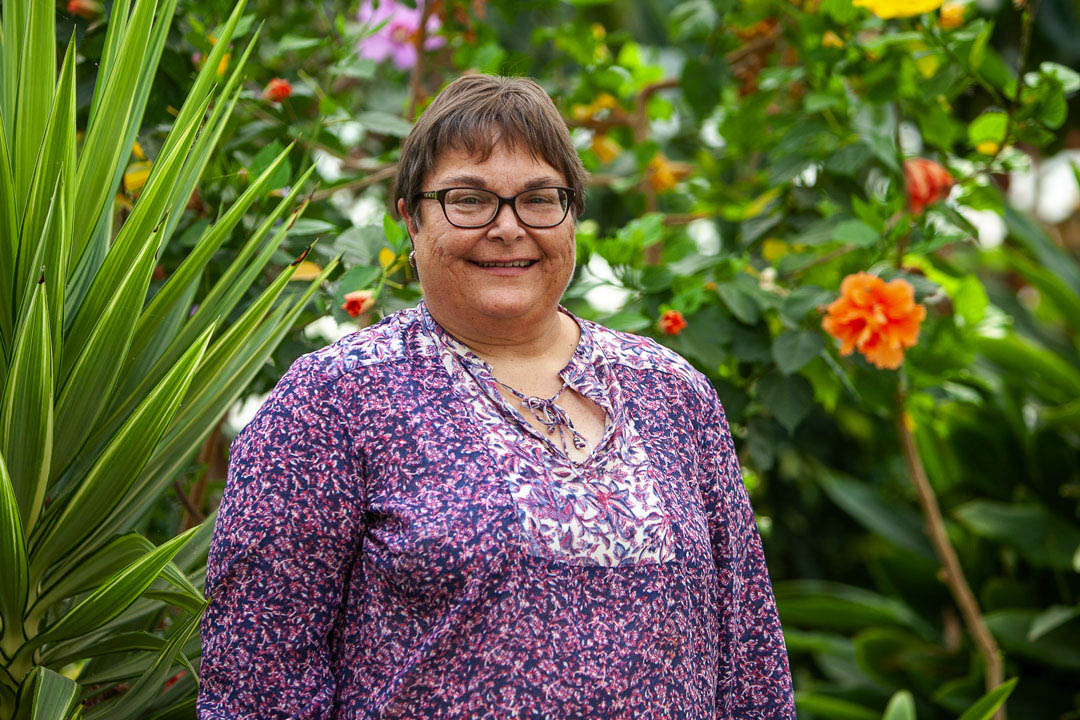
For the love of plants
Jackie Bantle brings passion to the role of greenhouse manager.
By Jane CaulfieldThe agricultural greenhouses on campus are where innovation (quite literally) grows and blooms. For greenhouse and horticulture facility manager, Jackie Bantle, the greenhouses, the horticulture field lab, and all the green spaces she is responsible for are joyful places as well.
“Just seeing things grow – planting something in the spring and seeing it through to harvest; I find that amazing,” she said. “I love just watching things grow.”
When she first attended the University of Saskatchewan (USask), Bantle got her degree in education feeling sure that she was meant to become a high school music teacher – she loved everything about the subject. But after a year and half of teaching high school students, she realized that career journey didn’t fit quite right.
“I really wanted to do something where I was outside,” she said. “So, I grabbed the university calendar and saw horticulture and was like ‘yeah!’ I mean, I liked being with flowers and I liked being outside, so I applied.”
She said it was student summer work opportunities and encouragement from professors that helped her find a groove and cultivate a deep love for all things horticulture.
“At that time, all of us students got to work in a large group at the field lab doing different things – one week on fruit, one week on vegetables and switch around, so it was a really great learning opportunity,” she said.
A lifelong passion
After graduating, Bantle landed a technician job working for one of her former professors.
“I remember that when one technician quit, she had been there for 10 years doing potatoes. And I thought to myself that I would never be at the university for 10 years. Now, it’s been almost 30 years. I’m a long hauler,” she said with a chuckle.
In those 30 years, Bantle has worked in a few areas, including vegetable research, accepting the role of greenhouse manager more than 10 years ago. For her, the job remains exciting because things must regularly adapt to meet changing needs of the College of Agriculture and Bioresources and its researchers.
“Things have really expanded since I started,” she said. “Now, I’m managing the greenhouse and the horticulture field lab as well as the Beamish Conservatory in the Agriculture Building. As I’ve been doing that job, there has been a lot more opportunities that have come up.”
Often, those opportunities are a way for Bantle to represent the college and its horticulture programming across the province, including the Saskatchewan Horticulture Association, The Gardener Magazine, and the Saskatchewan Greenhouse Growers Association.
“I also get to do a little bit of teaching and work with the Horticulture Club, which is what I really like – being around the university students,” she said.
A day in the life
A typical day includes running between the greenhouses and the horticulture field lab making sure that not only are things running smoothly, but that everyone has what they need to be successful in their research.
“I really like to think that we are here to support the research and that people have what they need to get their research done. Ultimately help make the work a little bit easier,” she said.
But, without missing a beat, Bantle quickly points out that it isn’t just a one-woman show and success really comes from the skills and abilities of the team working with her.
“I have excellent people working for me – I’d be lost without them, and I am always very grateful for them. It’s not just me doing this,” she said. “We have a lot of fun at work and we’re always learning new things.”
That sense of teamwork and support is common throughout the college and is a vital part towards its success.
“The hard work from Jackie’s team and her long-time commitment to the college are evident in the success of our greenhouses and horticulture facilities,” said Dr. Angela Bedard-Haughn (PhD), dean of the College of Agriculture and Bioresources. “She is one of the college’s 315 staff members – each one vital to the college’s mission to advance the responsible use of land, water and bioresources to provide products and services that enhance the quality of life for the people of Saskatchewan and around the world.”
A department ahead of its time
2021 marks 100 years of horticulture science at USask. Something Bantle said is a great honour to be a part of, considering many people don’t necessarily associate it with prairie farming.
“In some areas of the world, horticulture is big farming. But you can make a living in horticulture on a small area of land. A 70-acre vegetable farm is a big farm,” she said. “But it is also part art – you are making spaces beautiful. So, it’s a wider field – part science and part art.”
When considering how much money people spend on landscaping, or how most small towns have a golf course to maintain, it’s clear that horticulture in Saskatchewan has huge economic impact. This probably is why it was one of the earliest areas of agriculture being taught at USask.
“Horticulture has a really long history in the province,” she said. “Maybe because of the amount of labour required for it or our climate that we have, it doesn’t always get the recognition it should. But it is an important part of agriculture in Saskatchewan and what we do at the university.”
To learn more about 100 Years of Horticulture webinars and history, visit gardening.usask.ca/hort100.
Agknowledge, Fall 2021

